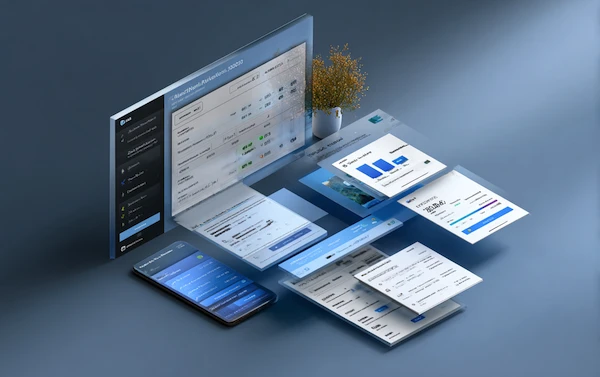Coming Up
What is Excel Reconciliation?
Excel reconciliation is the process of comparing two or more datasets within Microsoft Excel to ensure consistency and accuracy between them. This technique is widely used by finance and accounting professionals to verify that internal records align with external statements, such as bank records, vendor invoices, or intercompany transactions.
By leveraging Excel's functionalities, organizations can identify discrepancies, correct errors, and maintain accurate financial records.
Why is Excel Reconciliation Important?
Accurate financial records are the backbone of any organization. Excel reconciliation plays a crucial role in:
- Ensuring Data Integrity: By comparing datasets, organizations can detect and correct errors, ensuring the reliability of financial information.
- Compliance and Audit Readiness: Regular reconciliations help maintain compliance with accounting standards and prepare for audits by providing clear documentation of financial transactions.
- Fraud Detection: Identifying discrepancies early can help uncover fraudulent activities or unauthorized transactions.
- Informed Decision-Making: Accurate data enables better financial planning and decision-making.
What are the Benefits of Using Excel for Reconciliation?
Excel offers several advantages for reconciliation tasks:
- Flexibility: Excel can handle various types of data and allows for customized reconciliation processes.
- Accessibility: Most organizations already use Excel, reducing the need for additional software investments.
- Functionality: With built-in functions and tools, Excel can automate many aspects of the reconciliation process.
- Templates: Pre-built templates, such as Solvexia's free account reconciliation template, can streamline the process and ensure consistency.
What Are the Challenges of Excel Reconciliation?
While Excel is a powerful tool, it has limitations:
- Manual Errors: Manual data entry and formula errors can compromise the accuracy of reconciliations.
- Version Control: Collaborating on Excel files can lead to version control issues, making it difficult to track changes.
- Scalability: As data volumes grow, Excel may become less efficient and more prone to performance issues.
- Lack of Automation: Without additional tools or macros, many reconciliation tasks remain manual and time-consuming.
This is where automated reconciliation platforms like Solvexia offer a clear advantage. Solvexia removes the burden of manual reconciliations by automating data matching, exception reporting, and audit trails, enabling finance teams to focus on analysis rather than data wrangling. Solvexia helps businesses reduce risk, save time, and maintain consistent, audit-ready records.
What are the Key Features and Techniques in Excel Reconciliation?
Excel provides various functions and tools to facilitate reconciliation:
- VLOOKUP and XLOOKUP: These functions allow users to search for specific data across different datasets, making it easier to compare records.
- IF Statements: Used to create logical comparisons between datasets, highlighting discrepancies.
- Conditional Formatting: Visually identifies differences by applying specific formatting to cells that meet certain conditions.
- Pivot Tables: Summarize and analyze large datasets, helping to identify trends and discrepancies.
- COUNTIF and MATCH Functions: Useful for identifying duplicates or missing entries between datasets.
- Power Query (Get & Transform): Automates data import, transformation, and reconciliation processes.
- Macros and VBA: Automate repetitive tasks and complex reconciliation processes.
How Does Excel Reconciliation Work?
The reconciliation process in Excel typically involves the following steps:
- Data Import: Load internal and external datasets into Excel.
- Data Cleaning: Ensure data consistency by formatting dates, numbers, and text uniformly.
- Comparison: Use functions like VLOOKUP, IF, or MATCH to compare datasets and identify discrepancies.
- Analysis: Investigate discrepancies to determine their causes, such as timing differences or data entry errors.
- Adjustment: Make necessary corrections in the datasets to resolve discrepancies.
- Documentation: Record the reconciliation process and findings for audit purposes.
What are the Types of Reconciliation in Excel?
Excel can be used for various reconciliation types:
- Bank Reconciliation: Comparing internal cash records with bank statements to ensure consistency.
- Vendor Reconciliation: Matching accounts payable records with vendor statements.
- Intercompany Reconciliation: Ensuring transactions between subsidiaries are accurately recorded.
- Accounts Receivable Reconciliation: Aligning customer invoices with payments received.
- Balance Sheet Reconciliation: Verifying that balance sheet accounts are accurate and complete.
What are the Use Cases for Excel Reconciliation?
Excel reconciliation is applicable in various scenarios:
- Month-End Close: Ensuring all accounts are accurate before closing the books.
- Audit Preparation: Providing clear documentation of financial records for auditors.
- Fraud Detection: Identifying unauthorized transactions or discrepancies.
- Regulatory Compliance: Maintaining accurate records to comply with financial regulations.
- Financial Analysis: Ensuring data accuracy for budgeting and forecasting.
What Should You Look for in an Excel Reconciliation Tool?
When selecting tools or templates for Excel reconciliation, consider:
- Ease of Use: User-friendly interfaces and clear instructions.
- Automation Capabilities: Features like macros or Power Query to reduce manual work.
- Customization: Ability to tailor templates to specific reconciliation needs.
- Error Detection: Built-in checks to identify discrepancies and errors.
- Documentation: Sections to record reconciliation steps and findings for audit trails.
What are the Best Practices for Excel Reconciliation?
To ensure effective reconciliation:
- Regular Reconciliations: Perform reconciliations periodically, such as monthly or quarterly.
- Standardized Templates: Use consistent formats to reduce errors and improve efficiency.
- Data Validation: Implement checks to ensure data accuracy before reconciliation.
- Clear Documentation: Record all reconciliation steps and findings for transparency.
- Training: Ensure staff are proficient in Excel functions and reconciliation processes.
- Automation: Leverage Excel's automation features to minimize manual tasks.
How to Get Started with Excel Reconciliation Tools?
Starting with Excel reconciliation involves:
- Assessing Needs: Determine the types of reconciliations required.
- Selecting Templates: Choose appropriate templates, such as those offered by Solvexia, to match your reconciliation needs.
- Training: Familiarize your team with Excel functions and the chosen templates.
- Implementing Processes: Integrate reconciliation tasks into regular financial workflows.
- Reviewing and Improving: Regularly assess the effectiveness of reconciliation processes and make necessary adjustments.
How Solvexia Helps with Excel Reconciliation
Solvexia enhances traditional Excel reconciliation by automating manual tasks and improving accuracy. With a no-code platform designed for finance teams, Solvexia streamlines data collection, validation, matching, and exception management—freeing teams from time-consuming spreadsheets.
Key benefits include:
- Automated data matching and exception handling
- Audit-ready documentation with full traceability
- No-code interface for fast implementation and updates
- Seamless integration with Excel and core financial systems
By replacing error-prone manual work with intelligent automation, Solvexia empowers teams to accelerate financial closes, reduce risk, and focus on high-value analysis.
Explore our reconciliation automation solution and learn how we can help you can transform your processes.
.svg)





























